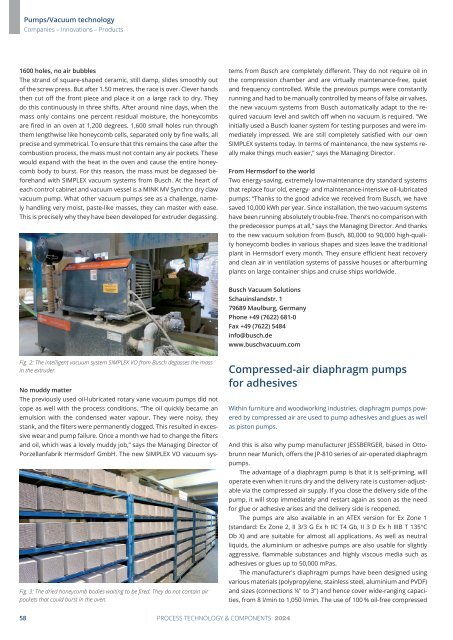PuK - Process Technology & Components 2024
A technical trade magazine with a history of more than 60 years.
A technical trade magazine with a history of more than 60 years.
You also want an ePaper? Increase the reach of your titles
YUMPU automatically turns print PDFs into web optimized ePapers that Google loves.
Pumps/Vacuum technology<br />
Companies – Innovations – Products<br />
1600 holes, no air bubbles<br />
The strand of square-shaped ceramic, still damp, slides smoothly out<br />
of the screw press. But after 1.50 metres, the race is over. Clever hands<br />
then cut off the front piece and place it on a large rack to dry. They<br />
do this continuously in three shifts. After around nine days, when the<br />
mass only contains one percent residual moisture, the honeycombs<br />
are fired in an oven at 1,200 degrees. 1,600 small holes run through<br />
them lengthwise like honeycomb cells, separated only by fine walls, all<br />
precise and symmetrical. To ensure that this remains the case after the<br />
combustion process, the mass must not contain any air pockets. These<br />
would expand with the heat in the oven and cause the entire honeycomb<br />
body to burst. For this reason, the mass must be degassed beforehand<br />
with SIMPLEX vacuum systems from Busch. At the heart of<br />
each control cabinet and vacuum vessel is a MINK MV Synchro dry claw<br />
vacuum pump. What other vacuum pumps see as a challenge, namely<br />
handling very moist, paste-like masses, they can master with ease.<br />
This is precisely why they have been developed for extruder degassing.<br />
tems from Busch are completely different. They do not require oil in<br />
the compression chamber and are virtually maintenance-free, quiet<br />
and frequency controlled. While the previous pumps were constantly<br />
running and had to be manually controlled by means of false air valves,<br />
the new vacuum systems from Busch automatically adapt to the required<br />
vacuum level and switch off when no vacuum is required. “We<br />
initially used a Busch loaner system for testing purposes and were immediately<br />
impressed. We are still completely satisfied with our own<br />
SIMPLEX systems today. In terms of maintenance, the new systems really<br />
make things much easier,” says the Managing Director.<br />
From Hermsdorf to the world<br />
Two energy-saving, extremely low-maintenance dry standard systems<br />
that replace four old, energy- and maintenance-intensive oil-lubricated<br />
pumps: “Thanks to the good advice we received from Busch, we have<br />
saved 10,000 kWh per year. Since installation, the two vacuum systems<br />
have been running absolutely trouble-free. There’s no comparison with<br />
the predecessor pumps at all,” says the Managing Director. And thanks<br />
to the new vacuum solution from Busch, 80,000 to 90,000 high-quality<br />
honeycomb bodies in various shapes and sizes leave the traditional<br />
plant in Hermsdorf every month. They ensure efficient heat recovery<br />
and clean air in ventilation systems of passive houses or afterburning<br />
plants on large container ships and cruise ships worldwide.<br />
Busch Vacuum Solutions<br />
Schauinslandstr. 1<br />
79689 Maulburg, Germany<br />
Phone +49 (7622) 681-0<br />
Fax +49 (7622) 5484<br />
info@busch.de<br />
www.buschvacuum.com<br />
Fig. 2: The intelligent vacuum system SIMPLEX VO from Busch degasses the mass<br />
in the extruder.<br />
No muddy matter<br />
The previously used oil-lubricated rotary vane vacuum pumps did not<br />
cope as well with the process conditions. “The oil quickly became an<br />
emulsion with the condensed water vapour. They were noisy, they<br />
stank, and the filters were permanently clogged. This resulted in excessive<br />
wear and pump failure. Once a month we had to change the filters<br />
and oil, which was a lovely muddy job,” says the Managing Director of<br />
Porzellanfabrik Hermsdorf GmbH. The new SIMPLEX VO vacuum sys-<br />
Fig. 3: The dried honeycomb bodies waiting to be fired. They do not contain air<br />
pockets that could burst in the oven.<br />
Compressed-air diaphragm pumps<br />
for adhesives<br />
Within furniture and woodworking industries, diaphragm pumps powered<br />
by compressed air are used to pump adhesives and glues as well<br />
as piston pumps.<br />
And this is also why pump manufacturer JESSBERGER, based in Ottobrunn<br />
near Munich, offers the JP-810 series of air-operated diaphragm<br />
pumps.<br />
The advantage of a diaphragm pump is that it is self-priming, will<br />
operate even when it runs dry and the delivery rate is customer-adjustable<br />
via the compressed air supply. If you close the delivery side of the<br />
pump, it will stop immediately and restart again as soon as the need<br />
for glue or adhesive arises and the delivery side is reopened.<br />
The pumps are also available in an ATEX version for Ex Zone 1<br />
(standard: Ex Zone 2, II 3/3 G Ex h IIC T4 Gb, II 3 D Ex h IIIB T 135°C<br />
Db X) and are suitable for almost all applications. As well as neutral<br />
liquids, the aluminium or adhesive pumps are also usable for slightly<br />
aggressive, flammable substances and highly viscous media such as<br />
adhesives or glues up to 50,000 mPas.<br />
The manufacturer's diaphragm pumps have been designed using<br />
various materials (polypropylene, stainless steel, aluminium and PVDF)<br />
and sizes (connections ¼" to 3") and hence cover wide-ranging capacities,<br />
from 8 l/min to 1,050 l/min. The use of 100 % oil-free compressed<br />
58 PROCESS TECHNOLOGY & COMPONENTS <strong>2024</strong>

















